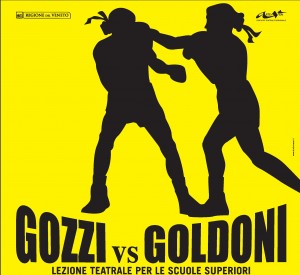Giants of Commedia: Gozzi vs. Goldoni
During the mid-1700’s, (over 100 years after Flamino Scala) two commedia performers/playwrights were having a feud over the future of commedia. They were both named Carlo, they were both Venetian, and they both had very different ideas about what made commedia dell’arte special and worthwhile.
Carlo Goldoni (1707-1793) was for getting rid of the masks and improvisatory nature of commedia and focusing on scripts and situations.
Making plays wittier, classier, and more suitable for the audiences (upper crust socialites and the burgeoning bourgeoisie) . His plays (such as The Servant of Two Masters and La Locandiera (The Mistress of the Inn) featured commedia characters, but they were in situations that the audience could recognize and empathize with.
Carlo Gozzi (1720-1806) was more interested in the fantastical elements of Commedia- outrageous masks, improvised scenarios, and magical and unexplained phenomena. His play The Love of Three Oranges features a king who will die if he doesn’t smile or receive 3 oranges. Another of his plays, the King Stag features a magical transformation of the hero into a deer and a lie-detecting statue.
I like to see this as a battle between street theatre and professional theatre. Gozzi represented popular theatre and street theatre and even the sometime unsavory elements that go along with that kind of performance.  Goldoni represented the professional theatre as we know it today.
It would be the difference between the old Cirque du Soleil (ragtag street performers who managed to spend every last dime on their tour) vs. the much more corporate Cirque du Soleil of today. Not passing any judgements, mind you– but there is a different aesthetic and a different sense of immediacy.
My personal aesthetics run more towards the Gozzi side than the Goldoni side, but I appreciate both. There is something wonderful and vulgar and captivating about thinking of these performers not as super-stars on a stage, but in an open market set competing with mountebanks selling fake medicine, tin cups disguised as pewter, and all manners of farm animals. They had to come to the market and win the audiences with their skills.
The graphic poster above comes from an Italian project that completed in 2007 called Gozzi vs. Goldoni. You can find out more about it here.
Read Gozzi’s memoirs here.
Read some of Goldoni’s comedies here
A pretty good description of their feud is here





Adam, I’ve always been a fan of both these guys–and have directed plays by both, the most recent being Goldoni’s “The Ingenious Chambermaid” at Colorado U in Boulder, in a translation by Carlo Mazzone-Clementi and Jane Hill (founders of Dell’Arte International in Blue Lake). Goldoni is a forerunner of the modern comedy of character– you can just tell that everyone of his characters in Chambermaid was based on great observation of a real person, all so unique and eccentric that they are every bit as fun to play as the stock characters. The most bourgeois commedia I ever saw was Julie Taymor’s version of Gozzi’s “King Stag” at ART, gorgeous to look at but totally sanitized for its audience; and there are rock n’ roll versions of “Servant of Two Masters.” I think at this point in time, how we relate to these two giants can be a matter of how their plays get interpreted. What their rivalry mainly makes me think about is how great it must have been to live in a time when the public rioted in the streets over who was the best playwright!!!
I agree that in today’s culture NOW interpretation is key, and that Goldoni plays can be full of amazing bits of life and invention and and that Gozzi plays can be D.O.A. —
I guess what I meant is that Goldoni wanted to get away from what he thought of as “Street Culture” and Gozzi wanted to embrace it, and I too want to embrace it rather than sweep it under the rug.
If Keith Haring had gotten all hoity-toity and started to pretend he didn’t start out as a tagger and then started to decry the taggers– even the good ones– then I’d cry the same foul.